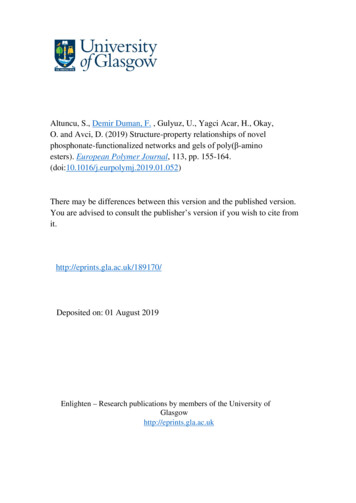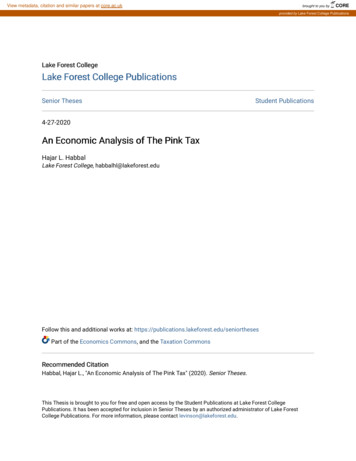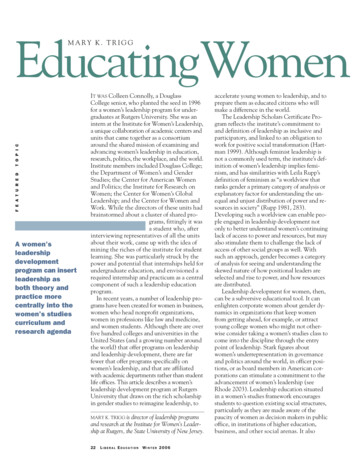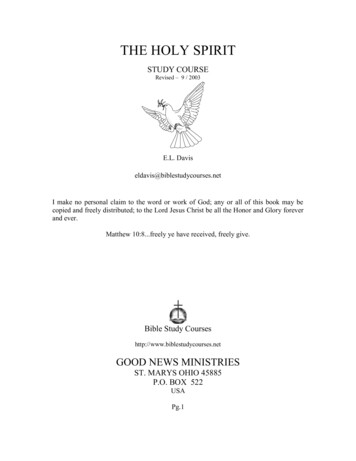
Transcription
Altuncu, S., Demir Duman, F. , Gulyuz, U., Yagci Acar, H., Okay,O. and Avci, D. (2019) Structure-property relationships of novelphosphonate-functionalized networks and gels of poly(β-aminoesters). European Polymer Journal, 113, pp. 155-164.(doi:10.1016/j.eurpolymj.2019.01.052)There may be differences between this version and the published version.You are advised to consult the publisher’s version if you wish to cite fromit.http://eprints.gla.ac.uk/189170/Deposited on: 01 August 2019Enlighten – Research publications by members of the University ofGlasgowhttp://eprints.gla.ac.uk
Structure-property relationships of novel phosphonate-functionalizednetworks and gels of poly( -amino esters)Seckin Altuncu a, Fatma Demir Duman b, Umit Gulyuz c, d, Havva Yagci Acar b, Oguz Okay d,Duygu Avci aaDepartmentof Chemistry, Bogazici University, Bebek 34342, Istanbul, TurkeybDepartmentof Chemistry, Koc University, Sariyer 34450, Istanbul, TurkeycDepartmentof Chemistry, Istanbul Technical University, Maslak 34469, Istanbul, TurkeydDepartmentof Chemistry and Chemical Processing Technologies, Kirklareli University,Luleburgaz 39750, Kirklareli, TurkeyCorrespondence to: D. Avci (E-mail: avcid@boun.edu.tr)Telephone: 90 212 359 4769.AbstractpH sensitivity, biodegradability and high biocompatibility make poly( -amino esters) (PBAEs)important biomaterials with many potential applications including drug and gene delivery andtissue engineering, where their degradation should be tuned to match tissue regeneration rates.Therefore, we synthesize novel phosphonate-functionalized PBAE macromers, andcopolymerize them with polyethylene glycol diacrylate (PEGDA) to produce PBAE networksand gels. Degradation and mechanical properties of gels can be tuned by the chemical structureof phosphonate-functionalized macromer precursors. By changing the structure of the PBAEmacromers, gels with tunable degradations of 5-97% in 2 days are obtained. Swelling of gelsbefore/after degradation is studied, correlating with the PBAE identity. Uniaxial compressiontests reveal that the extent of decrease of the gel cross-link density during degradation is muchpronounced with increasing amount and hydrophilicity of the PBAE macromers. Degradationproducts of the gels have no significant cytotoxicity on NIH 3T3 mouse embryonic fibroblastcells.-1-
Keywords: poly ( -amino esters); biodegradable polymer; phosphonate; mechanical properties1. IntroductionPhotopolymerizable biodegradable materials have been used in a wide range of biomedicalapplications such as tissue engineering and drug delivery because of their advantages of in vivocuring and no requirement of removal surgery [1-5]. Synthetic polymers have been utilized dueto their adjustable chemical, physical and biological properties such as hydrophobicity, surfacecharge, degradation, porosity, mechanical properties and cell adhesion behavior [6-7].Poly( -amino ester)s (PBAEs) are an important class of biodegradable synthetic polymerswhich are being investigated as gene [8-15] and drug [16-21] delivery vehicles and tissueengineering scaffolds [22-34] due to their pH sensitivities, biodegradabilities and highbiocompatibilities. They are easily prepared by Michael addition of difunctional amines tocommercial diacrylates under mild conditions and are degradable to diols, bis( -aminoacids),and poly(acrylic acid) chains under physiological conditions by cleavage of ester linkages dueto hydrolysis. Acrylate terminated PBAEs can be easily prepared using acrylate/amine molarratios 1 and can be photopolymerized into degradable networks. To illustrate, a combinatorialapproach was used to synthesize PBAE gels with a wide range of degradation times andmechanical properties for tissue engineering applications [22]. The effects of macromerstructure and molecular weight on network properties such as degradation rate, mechanicalproperties and cell interactions were investigated [23,24]. The influence of macromer branchinginvestigated by adding a trifunctional monomer showed a dose dependent improvement innetwork properties such as compressive modulus, tensile modulus and Tg [25]. Some PBAEmacromers were electrospun into scaffolds with diverse properties [26,27]. Fast degradingPBAE gels were used as porogens in a slower degrading PBAE matrix to generate scaffolds for-2-
tissue growth [29]. Trigger-responsive PBAE hydrogels with acid sensitive and reductionresponsive diacrylates were utilized for protein encapsulation [30].Although properties such as the chemical structure of PBAE macromer, its molecular weight,branching etc. allow customization of network properties, the gels still undergo degradation andlose their mechanical properties too fast for most biomedical applications. One way to matchthe gels’ properties to a desired application is to prepare their copolymers or composites. Forexample, PBAE macromers were used as crosslinkers for the synthesis of 2-hydroxyethylmethacrylate (HEMA) and N-vinylpyrrolidone (NVP) hydrogels to enhance the hydrogels’swelling and degradation properties [31]. Semi-degradable polymer networks, copolymers ofPBAE macromers and methyl methacrylate, were prepared to control and enhance mechanicalproperties during degradation [32,33]. It was shown that as the low Tg component degrades, theTg of the network and hence its modulus increases to give materials with tailorable toughness.Calcium sulfate/PBAE biodegradable hydrogel composites were developed to help verticalbone regeneration by preventing soft tissue infiltration [34].Phosphorous-based materials have been widely used in the biomedical field due to theirbiodegradable, hemocompatible and protein resistant nature [35]. Incorporation of phosphorouscontaining groups to polymeric networks extends their application areas due to their stronginteraction with hydroxyapatite-based tissue [36-39] and enhances their cell adhesion, [40-45]swelling and thermal properties. Recently, we have reported the effect of the phosphonate andbisphosphonate group on PBAE network properties [46-48]. Phosphonate-functionalizedPBAE macromers were synthesized through reaction of various diacrylates and a primaryphosphonate-functionalized amine (diethyl 2-aminoethylphosphonate). It was found that theirgels, except polyethylene glycol diacrylate (PEGDA)-based ones, support the attachment of alarger number of SaOS-2 cells than nonphosphonated ones [46]. Bisphosphonatefunctionalized PBAE gels with different chemistries exhibited similar degradation behavior,indicating that the hydrophilic nature of the bisphosphonate functional groups dominates all the-3-
other effects and leads to the high mass loss. These macromers were used as crosslinkers forthe synthesis of HEMA hydrogels, conferring small and customizable degradation rates uponthem [47].Although PEGDA hydrogels are one of the most widely studied biomaterials due to theirbiocompatibility and bioinertness, they have very slow degradation in vivo and hence areunsuitable for long-term implant applications. Therefore, it is desirable to adjust theirdegradation by functionalization to match tissue regeneration rates. In this study, we havesynthesized novel phosphonate-functionalized PBAE macromers through Michael addition ofa new difunctional phosphonated secondary amine and three different diacrylates with varioushydrophilic/hydrophobic properties. The macromers were then copolymerized with PEGDA,to form gels with tunable degradation and mechanical properties. We focus on the effect of thechemical structure of PBAE macromers on gel properties such as swelling and degradation.Moreover, for the first time in the literature, we have also studied the mechanical properties ofthe gels as a function of the type and the amount of the macromers. As will be seen below, wewere able to tune the degradation rate of gels and their cross-link density by changing theamount and hydrophilicity of PBAE macromers, to match those desired for tissue engineeringapplications.2. Materials and Methods2.1. ylphosphonate,1,6-hexanedioldiacrylate(HDDA), poly(ethylene glycol) diacrylate (PEGDA, Mn 575 Da), 1,6-hexanediol ethoxylatediacrylate (HDEDA), 1,8-diazabicyclo[5.4.0]undec-7-ene (DBU) and 2,2-dimethoxy-2phenylacetophenone (DMPA) were commercially available from Aldrich Chemical Co. andwere used as received. Roswell Park Memorial Institute (RPMI) 1640 medium (with L-4-
glutamine and 25 mM HEPES), penicillin/streptomycin (pen-strep) and trypsin-EDTA werepurchased from Multicell, Wisent Inc. (Canada). Fetal bovine serum (FBS) was obtained fromCapricorn Scientific GmbH (Germany). Thiazolyl blue tetrazolium bromide (MTT) andphosphate buffered saline (PBS) tablets were provided by Biomatik Corp. (Canada). The 96well plates were purchased from Nest Biotechnology Co. Ltd. (China). NIH 3T3 mouseembryonic fibroblast cells were a kind gift of Dr. Halil Kavakli (Department of MolecularBiology and Genetics, Koc University, Istanbul, Turkey).2.2. Methods1H, 13Cand31PNMR spectra were measured with a Varian Gemini 400 spectrometer usingdeuterated chloroform (CDCl3) or methanol (MeOD) as solvent. Chemical shifts ( werereported as ppm downfield from tetramethylsilane (TMS) as an internal standard. Couplingconstants (J) were given in hertz (Hz). IR spectra were obtained on a Thermo Scientific Nicolet6700 FTIR spectrometer in the range of 4000–650 cm-1. Potentiometric titrations were carriedout using a WTW Inolab 720 pH meter and WTW SenTix 41 epoxy pH electrode at roomtemperature. Glass transition temperatures (Tg) of the macromers and gels were determined byusing a differential scanning calorimeter (DSC, TA Instruments, Q100). The samples wereanalyzed at a heating rate of 10 C/min and in a temperature range of -90–200 C. Degradationstudies were done using a VWR Incubating Mini Shaker operating at 37 C and 200 rpm.2.3. Synthesis of tetraethyl sphonate)(PA)Method 14,9-dioxa-1,12-dodecanediamine (0.5 g, 0.52 mL, 2.45 mmol) and diethyl vinylphosphonate(0.84 g, 0.79 mL, 5.15 mmol) were mixed at room temperature for two days. The mixture was-5-
washed with hexane to remove unreacted diethyl vinylphosphonate and the pure product wasobtained as colorless liquid in 85% yield.Method 24,9-dioxa-1,12-dodecanediamine (0.5 g, 0.52 mL, 2.45 mmol) and diethyl vinylphosphonate(0.80 g, 0.75 mL, 4.89 mmol) were mixed in water (1.5 mL) at 85 С for 45 min. After removalof water, the mixture was washed with hexane to remove unreacted starting materials and thepure product was obtained as colorless liquid in 74% yield.1H-NMR(400 MHz, CDCl3, ): 1.31 (t, 3JHH 8 Hz, 12H, CH3), 1.60 (m, 4H, CH2-CH2-NH),1.74 (quint, 3JHH 8 Hz, 4H, CH2), 1.94 (m, 4H, CH2-P O), 2.68 (t, 3JHH 8 Hz, 4H, CH2NH) 2.88 (m, 4H, CH2-CH2-P O), 3.40 (t, 3JHH 8 Hz, 4H, CH2-O), 3.45 (t, 3JHH 4 Hz, 4H,CH2-O), 4.09 (m, 8H, CH2-O-P O) ppm.13C-NMR(100 MHz, CDCl3, ): 16.35, 16.41 (d,CH3), 25.68, 27.07 (d, CH2-P O), 26.30 (CH2), 29.93 (CH2-CH2-NH), 43.23, 43.25 (d, NHCH2-CH2-P O), 46.86 (CH2-NH), 61.51, 61.58 (d, CH2-O-P O), 69.09 (CH2-O), 70.63 (CH2O) ppm. 31P-NMR (162 MHz, CDCl3, ppm FTIR (ATR): 3503 (N-H), 2935 (C-H),1236 (P O), 1022, 954 (P-O) cm-1.2.4. Synthesis of PBAE macromersMethod 1The diacrylates (PEGDA, HDEDA or HDDA) and PA were mixed at a molar ratio of 1.1:1,1.2:1 and 1.3:1 in 10 mL vials at room temperature for 4 days while stirring. If the stirring wasstopped due to an increase in viscosity, a very small amount of dichloromethane (DCM) wasadded to the mixture and removed under reduced pressure after the reactions. The macromerswere obtained as colorless viscous liquids in 78-85% yield after washing with petroleum ether(HDEDA and HDDA-based ones) or diethyl ether (PEGDA-based ones) to remove unreacteddiacrylates, PA or monoaddition products; and dried under reduced pressure.-6-
Method 2PA (0.5 g, 0.94 mmol) and DBU (0.14 g, 0.14 mL, 0.94 mmol) were mixed in MeOH (1 mL).Then PEGDA (0.65 g, 0.58 mL, 1.13 mmol) was added and the mixture was stirred at roomtemperature for 12 h. After removal of MeOH, the residue was washed with diethyl ether toremove unreacted diacrylates, PA or monoaddition products; and dried under reduced pressureto give the product in 32-35 %.2.5. pKb measurementsThe pKb values of the macromers were determined by titration method. 50 mg of macromerwas dissolved in deionized water to give a final concentration of 1.0 mg/mL. The pH of themacromer solutions was set to pH 2.0 using 2 M HCl and titrated to pH 11 with 0.1 M NaOHsolution. The pH of solutions was measured after each addition using a pH meter (WTW InolabpH 720) at room temperature. The pKb value was determined from the inflection point of thetitration curve which responds to the pH value where 50% of protonated amine groups areneutralized.2.6. Synthesis of PBAE gelsA 10 % (w/v) DMPA solution in DCM was added to a macromer-PEGDA mixture (80:20 or50:50 w% PEGDA:macromer) to give a final concentration of 1 w% DMPA. After the removalof the solvent in a vacuum oven, the mixture was placed into a vial and polymerized in aphotoreactor containing 12 Philips TL 8W BLB lamps, exposing it to UV light (365 nm) for 30min. For comparison, the macromers alone were also polymerized under the same conditions.The polymer samples thus formed were weighed and immersed in ethanol for approximately12 h to remove unreacted components. After drying in a vacuum oven until constant weight,the samples were weighed again (final mass). The gel fraction Wg, that is, the fraction ofinsoluble polymer, was calculated from the initial and final mass of the gel specimens.-7-
2.7. Swelling StudiesSwelling studies were conducted by immersing dry gel samples (45 15 mg) into PBS (pH 7.4)solution at 37 C. The samples were removed from the solution at pre-determined time intervals,blotted on filter paper and the swollen weight was measured. The increase in the weight of thesamples was recorded as a function of time until equilibrium was reached. The degree ofswelling (Q) was calculated using the equation:𝑄 𝑊𝑠 ‒ 𝑊𝑑𝑊𝑑 𝑥 100(1)where Ws and Wd refer to the weight of swollen and dry samples respectively. The average dataobtained from triplicate measurements were reported. The standard deviations were less than5.2%.2.8. Degradation studiesIn vitro degradation of the gel samples as prepared above (45 15 mg, initial mass) were carriedout in PBS (pH 7.4) solution at 37 C on a temperature-controlled orbital shaker constantlyagitated at 200 rpm. At various time (2 days, 1, 2 and 4 weeks) points, three samples wereremoved, lyophilized and weighed (final mass). The mass loss was calculated from the initialand final mass values.2.9. Mechanical AnalysisMechanical properties of PBAE gels in equilibrium with PBS solution were determined throughuniaxial compression measurements on a Zwick Roell test machine using a 500 N load cell ina thermostated room at 23 2 C. The cylindrical gel samples were cut into cubic samples withdimensions 3x4x4 mm. Before the tests, a complete contact between the gel specimen and themetal plate was provided by applying an initial compressive force of 0.01 N. The tests werecarried out at a constant cross-head speed of 1 mm·min 1. Compressive stress is presented by-8-
its nominal value nom, which is the force per cross-sectional area of the undeformed gelspecimen, while strain is given by ε which is the change in the specimen length with respect toits initial length. Young’s modulus E of the hydrogels was calculated from the slope ofstress strain curves between 10 and 15% compressions. For reproducibility, at least threesamples were measured for each gel and the results were averaged.2.10. In vitro cytotoxicity assayNIH 3T3 cells were used to evaluate the cytotoxicity of the degradation products of the preparedgels. The cells were cultured in RPMI 1640 complete medium supplemented with 10% (v/v)FBS and 1% (v/v) pen-strep in 5% CO2-humidified incubator at 37 ºC and passaged every 2-3days. For the cytotoxicity assay, the cells were seeded at a density of 104 cells/well in RPMI1640 complete medium into 96-well plates and incubated at 37 ºC in 5% CO2 atmosphere until60-80% confluency. Then, the degradation products of the hydrogels in different concentrationsranging between 10-200 µg/mL were introduced into the wells. After 24 h further incubation,the cell viability was assessed using MTT colorimetric assay by the addition of 50 L of MTTsolution (5 mg/mL in PBS) into each well with 150 L of culture medium and incubated for 4more hours. The purple formazan crystals formed as a result of mitochondrial activity in viablecells were dissolved with ethanol:DMSO (1:1 v/v) mixture. Each sample’s absorbance at 600nm with a reference reading at 630 nm was recorded using a BioTek ELX800 microplate reader(BioTek Instruments Inc., Winooski, VT, USA). Cells which were not exposed to degradationproducts of gels were used as controls. 100% viability was assumed for the control cells; hencethe relative cell viability was calculated from equation ��𝑚𝑝𝑙𝑒𝐶𝑒𝑙𝑙 𝑣𝑖𝑎𝑏𝑖𝑙𝑖𝑡𝑦 (%) ��𝑡𝑟𝑜𝑙x 100(𝑛 4)-9-(2)
2.11. Statistical AnalysisStatistical analysis of the degradation products was conducted by using nonparametricKruskall–Wallis one-way analysis of variance followed by multiple Dunn’s comparison test ofGraphPad Prism 6 software package (GraphPad Software, Inc., USA). All measurements wereexpressed as mean values standard deviation (SD). p 0.05 was accepted as statisticallysignificant difference (n 5).3. Results and Discussion3.1. Synthesis of phosphonate-functionalized diamine and PBAE macromersA novel phosphonate-functionalized secondary diamine (PA) was synthesized via solvent-freeaza-Michael reaction between 4,9-dioxa-1,12-dodecane diamine and diethyl vinylphosphonate(Fig. 1). The molar ratio of the diamine to diethyl vinylphosphonate was fixed at 1:2.1 to fullyend-modify the amine and reaction was conducted at room temperature for two days (method1). The product was obtained as a colorless viscous liquid in high yields (85 %). However,shortening the reaction to 45 minutes at 85 ºC using water as solvent also produced good results(method 2), similar to refs. 49-51. It was reported that water activates the aza-Michael additionbetween amines and diethyl vinylphosphonates by both hydrogen bonding between water andphosphonate group and water and the amine [52]. PA is highly soluble in polar (water, ethanol)and weakly polar solvents (chloroform, diethyl ether), but insoluble in non-polar organicsolvents (hexane) (Table 1).- 10 -
Fig. 1. Synthesis of PA and PBAE macromers M1, M2, and, M3 derived from HDDA, HDEDA,and PEGDA, respectively.Table 1. Solubilities of PA and the synthesized macromers.Amine/MacromerCHCl3H2OPAM1M2M3 / Petroleumether -DiethylEther -HexaneEthanol- The structure of PA was confirmed by 1H-, 13C- and 31P-NMR and FTIR spectroscopy. Forexample, 1H NMR spectrum of the amine shows the characteristic peaks of methyl protons at1.31 ppm, methylene protons adjacent to phosphorus at 1.94 ppm and methylene protonsadjacent to nitrogen at 2.68 and 2.88 ppm (Fig. 2). The small shoulders of peaks at 1.94 and2.88 ppm are probably due to the small amount of diadduct (6 %) formation resulting from aslight excess of diethyl vinylphosphonate (2.1 mole) used compared to 4,9-dioxa-1,12dodecane diamine (1 mole). This side product, which is a tertiary amine, was not isolated sinceit will not undergo reaction with diacrylates used for PBAE synthesis. The 13C NMR spectrumof PA showed a doublet at 25.68, 27.07 ppm due to the carbon attached to phosphorus. TheFTIR spectra of PA showed absorption peaks of NH, P O and P-O at 3503, 1236, 1022 and954 cm-1.- 11 -
Three PBAE macromers with different backbone structures were synthesized (Method 1 inexperimental section; later method 2 [53] was applied to shorten the reaction time, but resultsfrom here on refer to macromers produced using method 1) from the step-growthpolymerization of three diacrylates (HDDA, HDEDA and PEGDA) and PA to evaluate howchemical alterations affect final properties of the resultant networks (Fig. 1). The diacrylate:PAmolar ratios were used as 1.1:1, 1.2:1 and 1.3:1 in order the obtain macromers with differentmolecular weights (Table 2). In the following, the macromers derived from HDDA, HDEDAand PEGDA are abbreviated as M1, M2, and M3, respectively. The hydrophilicity of themacromers increases in the order of M1 M2 M3. Their water-solubilities are highlydependent on the diacrylate they were synthesized from, e.g., M3 is soluble, M1 is not soluble,and M2 is slightly soluble, as expected from the order of their hydrophilicities (Table 1).- 12 -
Fig. 2. 1H NMR spectra of PA and M3 (PEGDA:PA mol ratio of 1.1:1).The structures of PBAE macromers were confirmed using 1H NMR spectroscopy (Fig. 2). Thepeaks at 5.8-6.5 demonstrate the maintenance of the acrylate terminal groups, and the averagenumber of repeat units (n) of the macromers was calculated via comparison of the areas of theacrylate protons (labeled as k and m at 5.8-6.5 ppm) to phosphonate ester (labeled as b at 1.3ppm or f, h at 3.4 ppm) protons, and was found as 5.0 (Mn 6300), 8.5 (Mn 7000) and 4.6- 13 -
(Mn 4400) for M3, M1 and M2 macromers respectively, prepared at 1.2:1 diacrylate:PA ratio.These molecular weights were higher than those obtained for their bisphosphonated analoguesbecause of lower steric hindrance of the PA [47]. FTIR spectra of the macromers show peaksat around 1020 and 950 cm 1 corresponding to the P-O stretching vibrations of phosphonategroups (Fig. 3).Fig. 3. FTIR spectra of M3, xl-M3-0 and xl-M3-0.8.The solubility of PBAEs depends on solution pH due to tertiary amines in their structures. Theabundance of these amine groups also give PBAEs high buffer capacity. Therefore, PBAEs canbe used as pH-responsive biodegradable polymers with tunable pH transition point for drug andgene delivery carriers. Their pH sensitivity can be modified by changing the diacrylates andthe amines [54,55]. In order to investigate the effect of PBAEs’ structure on their pHsensitivities acid-base titration method was used (Fig. 4). All the studied polymers exhibitedpH buffering capacities with slightly different buffering regions. The pKb values of M1, M2- 14 -
and M3 macromers with the lowest, medium, and highest hydrophilicity, respectively, werefound to be 5.5, 5.7 and 6.1, indicating effect of hydrophilicity on the pKb values. The electrondonating alkyl groups lead to high electron density on the nitrogen atom and hence decreasepKb, however oxygen atoms on HDEDA and PEGDA-based macromers are electronwithdrawing, hence partially cancel the effect of alkyl groups. Similar behavior was observedby Song et al. [55].Fig. 4. Titration curves of M1, M2 and M3 macromers derived from HDDA and PEGDA,respectively.PBAEs have low (sub-ambient) Tg due to their highly flexible structures resulting from the longethylene glycol or alkyl chains in their backbones and lack of rigid side groups [33]. The Tg’sof macromers were found to be -56, -59 and -60 ºC for M3, M2 and M1 macromers (Table 2).Table 2. PA:diacrylate ratios, number of repeat units (n), number average molecular weights(Mn) and Tg of the macromers.MacromerPA:diacrylaterationa- 15 -Mn aTg ( C)
59-56-from 1H NMR spectra3.2. Synthesis of PBAE networksThe mechanical properties of biodegradable polymers usually deteriorate in parallel with thebiodegradation after the polymer is implanted in the body; hence their use in load-bearingapplications is problematic. To address this problem, novel biodegradable polymer designs areinvestigated where the degradation rate can be tuned by minor modifications of structure. Forexample, Safranski et al. investigated thermo-mechanical properties of semi-degradable poly(βamino ester)-co-methyl methacrylate networks under simulated physiological conditions [33].These networks showed improved mechanical properties during degradation.The PBAE macromers synthesized in this work can be used to prepare gels with differenthydrophilicities and hence, different degradation and loss profiles affecting their mechanicalproperties. These macromers can also control the hydrophilic/hydrophobic properties of gelsthey are incorporated into. To investigate these features, copolymers of the synthesized PBAEmacromers with PEGDA were prepared by free radical polymerization under UV light usingDMPA as photoinitiator. For comparison, the reactions were also conducted in the absence ofthe PEGDA cross-linker. In the following, the gel compositions were designated as xl-Mi-w,where Mi denotes type of the macromer (i 1, 2, or 3 for HDDA, HDEDA, and PEGDA,respectively), w is the weight fraction of PEGDA in the comonomer feed (Table 3). Forinstance, xl-M1-0.80 presents the gel formed from HDDA macromer in the presence of 80 w%PEGDA, while xl-M1-0 denotes the gel obtained by homopolymerization of HDDA macromer(M1). After removal of unreacted macromers in ethanol, the gel fractions Wg were obtained as- 16 -
53-98%. FTIR analysis of the gel networks confirmed the presence of P O and P-O peaks at1244, 1024 and 952 cm 1 (Fig. 3). Glass transition temperatures Tg of PBAE networks with w 0.50 were around -50 C, similar to those of the macromers they were synthesized from(Table 3). The networks with a higher PEGDA content, i.e., at w 0.80 showed increased Tg(ca. -20 C) due to higher crosslink density resulting from the lower molecular weight ofPEGDA (Mn 570 Da). However, the networks with 50% PEGDA showed two Tg values (28 and -52 C for xl-M1-0.50; -50 and -40 C for xl-M3-0.50) (Table 3).This behavior isinterpreted as due to block copolymer structure and the two Tg values correspond to therespective ones of PBAE and PEGDA, showing the heterogeneity of the components.Table 3. Gel compositions, gel fraction Wg, degree of swelling Q, and Tg valuesNetworkWg (%)Q (%)Tg( C)xl-M1-064.5 2.6--53xl-M1-0 *53 4.2--xl-M1-0.5093.2 0.138.8 3.3-52, -28xl-M1-0.8091 2.231.3 4.0-21xl-M2-065.9 3.1--xl-M2-0 *79.8 2.4--xl-M2-0.5066.8 2.534.5 2.0-xl-M2-0.8086.2 1.128.6 2.1-24xl-M3-081.3 4.8--51xl-M3-0 *95.6 1.3--xl-M3-0.5091.0 1.051.6 3.0-50, -40xl-M3-0.8097.8 0.331.4 0.6-20*In the synthesis of macromers, diacrylate:amine molar ratio was used as 1.1:1.3.3. Swelling of networksThe gel networks were swollen in PBS (pH 7.4) to observe the influence of macromer molecularweight, amount and hydrophilicity of the macromer on their swelling behavior before and afterdegradation (Fig. 5). Before degradation, swelling degrees were low (28.6-51.6%) because both- 17 -
the macromer and PEGDA components of the networks are crosslinkers. Moreover, the amountof the macromer does not influence the swelling percentages except xl-M3-0.50. The presenceof HDEDA vs. HDDA in the backbone of the PBAE macromer was found to not make animportant difference in swelling; indicating that the hydrophilicities of the phosphonatefunctionalities and PEGDA determine the swelling. However, when PEGDA-based PBAEmacromer is used, the increased amount of PEGDA does make a difference, leading to theexception of xl-M3-0.50. This assertion is confirmed by the data of networks with 20 w%PBAE macromers (w 0.80), where the swelling percentages were found to be similar to thoseof the 50% (w 0.5) samples, the M3 sample showing only slightly higher swelling, since itaquires slightly higher amount of PEGDA with respect to M1 and M2 samples.Fig. 5. Swelling percentages (Q) of the gels before and after degradation for 2 weeks.The degradation of the gels over time have been monitored by the time-dependent swellingmeasurements. After degradation in PBS for 2 weeks, the swelling degree of degraded gelsincreased compared to those of non-degraded ones with the same composition (Fig. 5). Whilexl-M3-0.50 gel swelled 51.6% initially, after 2 weeks of degradation its swelling percentagewas found to be about 143.7%. The swelling of the degraded gels increases with an increase inboth PBAE content and its hydrophilicity, which also determines degradation rate of the gels.- 18 -
An explanation is that degradation destroys the integrity of the hydrogel and enhances thepenetration of water into the gel. This explanation was checked using mechanical testsconducted on virgin and degraded gels, as will be discussed later.3.4. Degradation of networksTissue-engineering scaffolds should both guide the proliferating cells to form new tissue, anddisappear when their job is completed. Therefore, the degradation rate of the scaffold should betuned such that it turns slowly into a porous matrix into which molecules can diffuse, cells enter,adhere, proliferate and interconnect; and breaks apart at the appropriate time. Hence it isimportant to investigate degradation behavior of any new candidates for tissue-scaffoldmaterials.Fig. 6 shows degradation of the PBAE gels in PBS (pH 7.4) at 37 C. The dependence ofdegradation rate on PBAE structure is clearly evident. The gels formed from more hydrophobicPBAE macromer degrade slower; degradation rates were found to increase in the followingorder: xl-M1 xl-M2 xl-M3, in accord with the order of the increase of hydrophilicity. Forexample, xl-M3 and xl-M1 gels degraded 80% and 15%, respectively, within 2 days. Thedegradation of xl-M2 gels was completed in 6 days, and xl-M3 gels in 3 days. The morehydrophobic xl-M1 network has lower water uptake and undergoes slower cleavage of esterlinkages compared to the other gels. Therefore, this trend was also consistent with the swellingbehavior (after 2 weeks), which is an indirect method for measurement of degradation. It wasalso observed that the gels formed using low molecular weight PBAE
which are being investigated as gene [8-15] and drug [16-21] delivery vehicles and tissue . PBAE macromers were used as crosslinkers for the synthesis of 2-hydroxyethyl methacrylate (HEMA) and N-vinylpyrrolidone (NVP) hydrogels to enhance the hydrogels' . tablets were provided by Biomatik Corp. (Canada). The 96-well plates were purchased .










